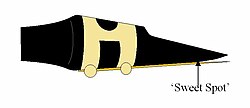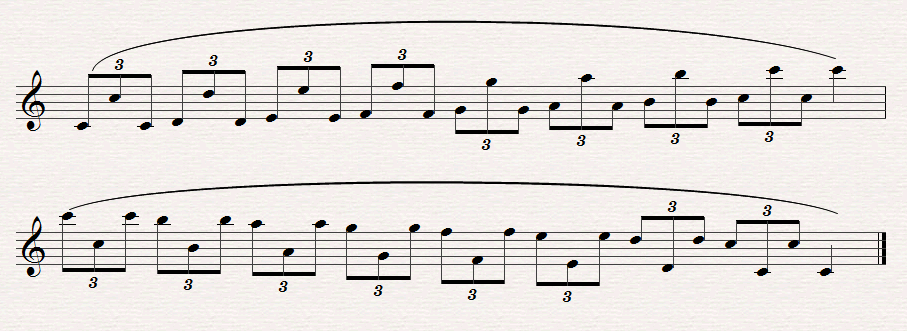Saxophone/Tone
Classical
[edit | edit source]Typical classical saxophone tone is pure and focused with a view to minimising ‘air sounds’ and variation across registers and dynamics. Nevertheless there is natural variation between all players’ ideals. To achieve a nice tone, you need a clear idea of the tone you want to create. The best way to form an idea of the tone you want to create is to listen to recordings of exceptional saxophonists.

To work on tone you need to experiment with adjusting both your embouchure and oral cavity. Ensure your mouth is straight on the saxophone as it is quite possible to develop a habit for playing ‘diagonally’ that is hard to break. To check, attach a piece of medical tape to the top of the mouthpiece at the start of each practice. While practicing look occasionally to see if you are pushing the tape down further on one side than on the other. Once you are in the habit of playing with your mouth straight on the mouthpiece you might consider attaching a mouthpiece patch permanently to your mouthpiece (usually purchasable from wherever you buy your reeds). This will form a dent where your top teeth go.

Something that can adversely affect your tone is muscle fatigue in your bottom lip. A common way to prevent this is using medical tape (or flower tape, or cigarette paper) as a cushion over your bottom teeth. Cut a length of tape about 4cm then fold it in half so there is no sticky side. Fold this over your lower teeth where they press against your lip to relieve some of the pressure. While playing make sure you breathe by dropping your lower jaw away from the reed rather than sucking air in the sides of your mouth as this momentarily takes the pressure off your lower lip. If you do play long enough that you hurt your lower lip, a mouth wash of warm salt water relieves the pain and Chap Stick on the outside will stop your lower lip drying out. Other embouchure factors that can be experimented with to change tone include how much mouthpiece you take in, how much of your bottom lip you curl under, how tight you ‘squeeze’ your lip muscles and how hard you ‘bite’ your jaw. Find a ‘sweet spot’ on the reed which is just where it splits from the mouthpiece and ideally where you place your lower lip. If you place it too far back you will lose control and if you place it too far forward you will make the tone nasal and tinny. To locate this spot try sliding a piece of paper between the reed and the mouthpiece. Where the paper stops sliding smoothly is where the reed leaves the mouthpiece.
As for how you hold your mouth, classical embouchure is quite focussed. Descriptions include ‘whistle embouchure,’ ‘oooh’ shaped mouth, and ‘play like you’re speaking with a French accent.’ Or, imagine the corners of your mouth are rock hard and your lower lip is a sling between them. Try to keep your lower jaw firm, especially in the lower register, but not biting, especially in the higher register. Your lip muscles should be quite tight (like sucking on a straw) but be careful the tone doesn’t become nasal.
Another factor in your tone is the shape of your oral cavity. As it is hard to describe the physical workings of your mouth it is more useful to think of metaphors. To focus your tone and help with air support, think of a hose pipe extending from your lungs to your lips without being distorted by your mouth the air should flow freely and directly along. Practicing breathing by dropping your lower jaw and inhaling on an ‘oh’ vowel will help keep your mouth set in the right position. Raising the back of your tongue will give you a more focussed tone and greater control but too far will cause it to sound ‘bent’ and ‘flat.’
When playing occasionally there will be a gurgling sound in the mouthpiece caused by saliva resulting in a ‘spitty’ tone. It is important to suck the saliva out of the mouthpiece regularly when playing to minimise this. Some people also coat the inside of the mouthpiece with Vaseline to help prevent it. If it occurs while playing, focusing the tone and improving air support can stop it. Sometimes it is also caused by your reed being over saturated if you have been playing for a while. Either change reeds or take your reed off, dry it on a tissue, and replace it.
The following exercises are for practicing and developing tone:
Constipated Scale
[edit | edit source]Play a descending two octave C major scale quite slowly. Try and make the tone as ‘squeezed’ and focused as possible tightening your lips and biting your jaw. The tone should be piercing and the last few notes should split to a higher overtone. Next play the same scale but as open and spread as possible. Think ‘BWAA BWAA BWAA.’ Drop your jaw and relax your embouchure so the notes are flat. The tone should be raucous and loud. Finally play with a tone you like somewhere in between the two.
Tone Matching
[edit | edit source]Often the notes that suffer in terms of tone are the ‘short tube’ notes such as A, B and C. To improve the tone quality of these notes, practice comparing them to ‘warmer’ notes and alternate fingerings. Middle D is a particularly warm note conveniently close in pitch to open C and C#. Practice alternating between these notes striving to make the open C and C# as warm and focused as the D as possible. The overtones above Bb have a particularly open, rich tone. Practice alternating from low Bb overblown an octave to a regular Bb fingering striving to maintain the openness and richness of tone.
Octaves
[edit | edit source]Another way to check if your embouchure is correct is to alternate quickly between octaves. Theoretically, you should have the same mouth pressure for all registers of the saxophone (except perhaps altissimo) and a common error is to relax pressure to get the lower notes to speak and to squeeze in the upper register. Practice slurring quickly between registers using only the octave key and keeping your embouchure the same. Or sustain the note and get someone else to press the octave key for you.

